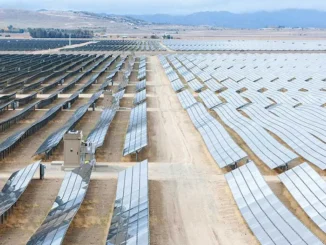
Massachusetts solar developers are routinely choosing to clear trees and other green space for commercial projects rather than build on vacant rooftops, according to state data.
As of July, building-mounted installations made up less than 2% of non-residential solar projects that have applied for funding from the state’s solar incentive program.
“We hear from [solar companies] constantly that it just doesn’t pencil out,” said state Rep. Lindsay Sabadosa. “It’s cheaper at the moment to buy land, clear cut it, and put up solar.”
While solar panels’ climate benefits generally surpass the loss of trees at a site, using green space for solar farms can disrupt habitats and views, sparking local opposition in some cases.
That’s why advocates are pushing for changes to the state’s incentives to make solar projects on rooftops, parking lots and other developed sites more enticing to developers.
Get connected
Every morning, thousands of energy professionals turn to our newsletters for the day’s most important news. Sign up for free to get the latest delivered straight to your inbox.
“From a clean energy standpoint, we want all the solar we can get, as fast as we can get it,” said Paul Dale, chair of the Massachusetts Sierra Club’s energy committee. “But we really want to be protecting our natural lands from being destroyed by a mad dash to do solar.”
A bill, H.3225, sponsored by Sabadosa and others would lift caps and restrictions on net metering for certain projects on rooftops, parking lots, and other disturbed sites, allowing bigger installations and creating higher payments for projects on these sites.
Solar is a key element in Massachusetts’ strategy for reaching its ambitious goal of going carbon-neutral by 2050. Gov. Maura Healey supports a target of getting 10 gigawatts of solar power online by 2030, an objective that would require a gigawatt of new solar power each year until then. By 2050, roughly 30 gigawatts will be needed to meet climate goals, according to a recent state report.
Building out enough solar to meet those targets will almost certainly require the use of some forested and agricultural lands, many advocates agree. However, shifting as much development as possible from rural areas to roofs, parking lots, and other previously disturbed land could have both environmental and economic benefits, they said.
Rooftop development adds renewable energy to the grid without destroying habitat or removing carbon-sequestering trees. Generating power close to the consumers who will be using it means less need to build out costly transmission infrastructure. And adding solar to commercial rooftops can add another revenue source for property owners facing a troubled commercial real estate market.
The problem isn’t the availability of rooftops. A recent state report analyzing Massachusetts’ potential for solar development found enough rooftop space available to site 40 gigawatts of solar capacity. The true potential is certainly less than this number, as the report did not consider several factors, such as building age and rooftop shading, in its analysis. Nonetheless, the report makes clear there is plenty of room to build more solar capacity atop existing buildings.
“There are a lot of great roofs out there,” said Ben Underwood, co-founder and co-chief executive of Resonant Energy, a Boston-based solar developer that works largely with nonprofits and affordable housing projects.
But the economics of building smaller rooftop systems or installing solar canopies in parking lots is much trickier than greenfield development.
The Solar Massachusetts Renewable Target program, known as SMART, functions on a system of declining incentives: As more solar capacity comes online, the payments available to future installations decrease. In the five years since the program launched, the incentives have declined significantly — in some regions, the payments for new projects have dried up entirely.
Furthermore, when developers begin planning a new project, it is unclear what incentive level will be available by the time they are approved for the program. This uncertainty does not sit well with site owners, said Quincy Vale, chair of Gridwealth, a developer of commercial and industrial rooftop solar projects. Though Gridwealth has built some 150 projects in Massachusetts, the company now finds itself needing to look elsewhere to keep its business going.
“It’s existential for my business in Massachusetts, I believe,” Vale said. “The fact is, I’ve had to shift my focus to developing in other states.”
In addition, owners of commercial buildings with ample roof space are often hesitant to make a long-term financial commitment like solar in case a more profitable plan comes their way in the shorter term, Underwood said. Installing solar on buildings can also mean a lot of time — and thus money — spent on coordinating with stakeholders such as tenants, investors, and boards of directors, rather than the single landowner generally involved in a large project on a greenfield.
Plans for parking lot canopies have an added challenge: The volatile price of steel, needed to build the support structures for canopies, has made the development of parking lot projects extremely difficult in recent years, Underwood said.
The SMART program offers added incentives for projects built on rooftops and parking lot canopies. But at the moment, Sabadosa said this money isn’t enough to cover the added cost of these projects, based on conversations with local solar companies.
It’s that economic gap that the new bill tries to address.
The legislation would increase the size of projects built on rooftops or disturbed land that are eligible for net metering credits from 2 megawatts to 5 megawatts. It would allow projects on buildings or previously disturbed land to receive net metering credits for 100% of the power they send to the grid, regardless of size; currently, new larger projects receive credits worth only 60% of their excess kilowatt-hours.
The bill would exempt solar developments on rooftops, parking canopies, and other disturbed or built sites from the SMART program’s declining incentive structure. Incentive payments would also have to respond to the market, increasing when there are price surges for important materials like steel, for example.
The legislation also calls for the Massachusetts Clean Energy Center, the state’s clean energy economic development agency, to create a program to help fund the replacement of older roofs to make them ready for solar installations.
“That would help directly counter the historic disinvestment in buildings in lower-income neighborhoods and directly help bring them back up to the level where wealthier neighborhoods already are,” Underwood said.
The bill is in the early stages of the legislative process but is cosponsored by 26 lawmakers, and has the backing of many solar developers and a coalition of environmental nonprofits including the Massachusetts Sierra Club, Mass Audubon, the Nature Conservancy, The Trustees of Reservations, Environment Massachusetts, and the Appalachian Mountain Club. State House and Senate committees held hearings on the bill in June, receiving universally positive feedback about the proposal. Supporters say the bill is unlikely to pass as standalone legislation, but some or all of its provisions could be wrapped into a larger climate bill.
The timeline is still uncertain, supporters said, but the need is clear and urgent in the face of the climate crisis.
“We’re really going to need to step up what we’re doing with solar,” Sabadosa said.



